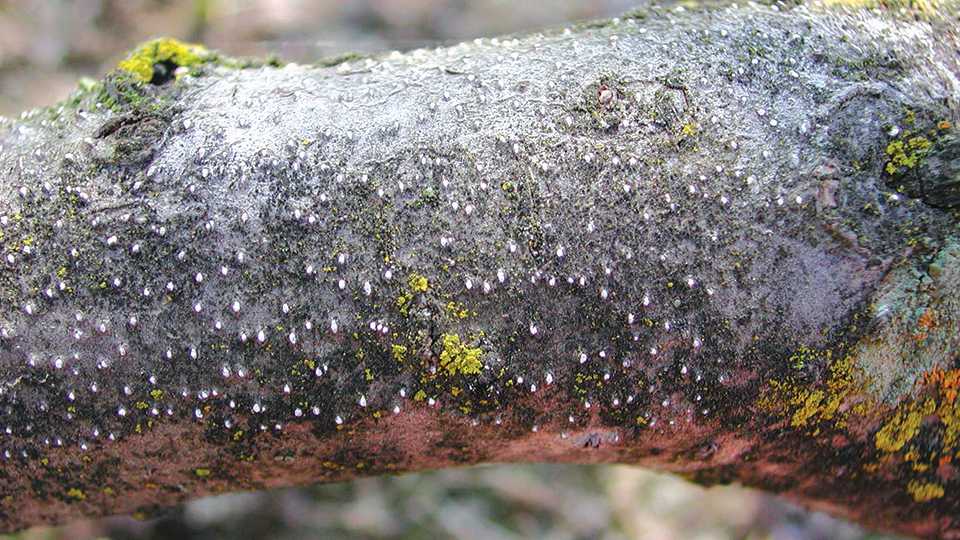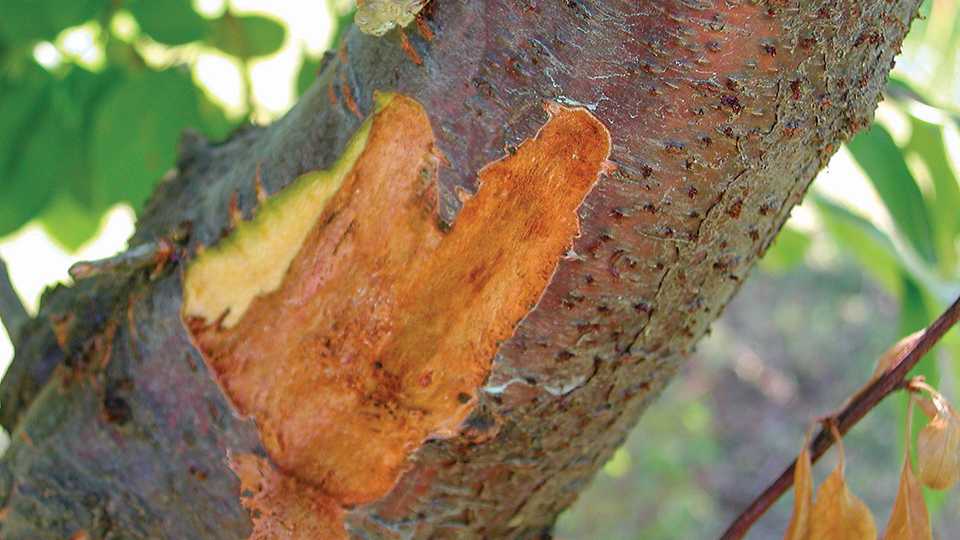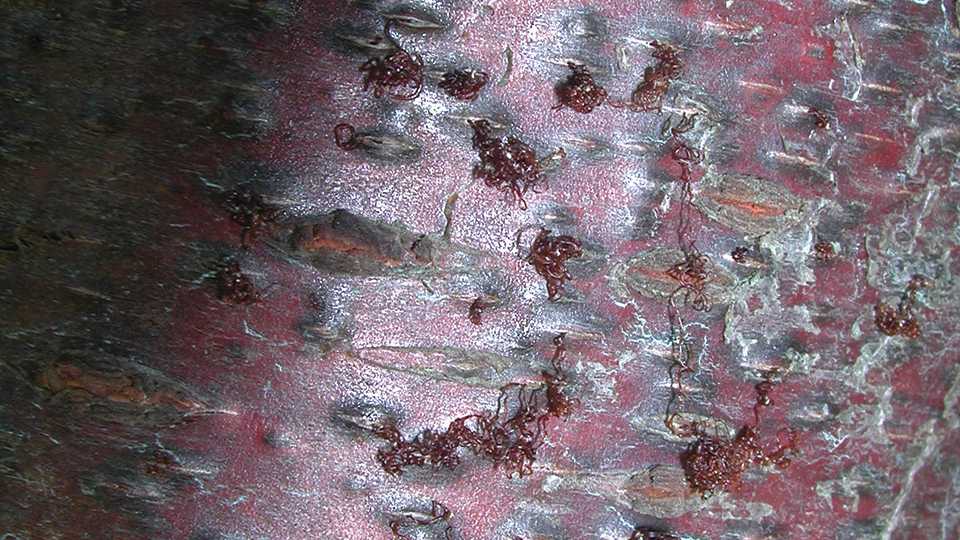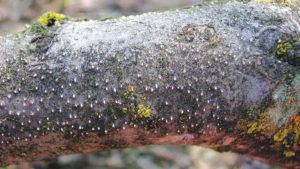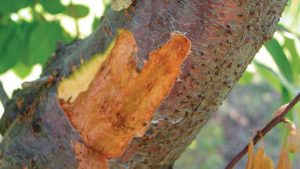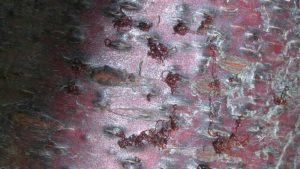Why Cytospora Is a Year-Round Fight for Prune Growers
Canker diseases threaten the profitability of prune growing, reducing bearing wood and killing entire trees early in the life of the orchard. These diseases include bacterial canker, Botryosphaeria, Phomopsis, etc. but especially Cytospora. This article is a review of Cytospora canker and a plea (suggestion?) for growers and PCAs to pay close attention to managing what was once largely a nuisance but now is an orchard-threatening problem. We will also review prune orchard management practices that help control Cytospora infections.
Why is the postharvest period so important in the year-round fight against Cytospora?
Cytospora canker is a bark canker caused by one or more species of the Cytospora fungus. Cytospora is a perennial canker; once in the tree it doesn’t die out in the year of infection. The only way to remove a Cytospora canker from a tree is to cut it out. It is active over a wide range of temperatures (40°F to 90°F), but is most active at higher temperatures (over 80°F). Tree stress is more frequent at higher temperatures because of the greater risk of water stress and potassium deficiency. Research results show an increased spread of the disease ― faster canker growth ― with postharvest water stress.
How does Cytospora infect a tree?
Cytospora is a relatively weak fungus that requires an opening in the tree’s protective bark ― it doesn’t infect flowers ― to infect prune trees. .) Such openings include sunburn, bacterial canker damage, and pruning wounds. Recent research by University of California (UC) Plant Pathologist Dr. Themis Michailides and his team have shown that Cytospora can enter prune trees through pruning wounds, something that was tested and found to be only a minor infection site in research from the 1970s. The UC IPM page for Cytospora management in prunes still states that “Pruning cuts … are not important infection sites.” This information is no longer accurate. UC IPM is working to update the entire “Prune Pest Management Guidelines.”
How does Cytospora spread in an orchard?
Spores oozing from pimple-like structures (pycnidia) on dead or dying wood are the primary source of new infections. The spores are not released in a dry form to move with the wind, but in a starchy strand (cirrus) that must be broken up and moved with wind-blown rain. New infections also require wet surfaces from rain or dew or 100% relative humidity for spore germination. Cutting out and burning dead/dying, infected wood is a critical management practice for this disease.
What are some possible reasons that may contribute to Cytospora canker becoming such an issue now, when it wasn’t several decades ago?
- New, more aggressive species of Cytospora may now be present in California orchards compared to decades ago.
- Reduced sanitation via pruning out and burning dead wood due to rising pruning costs and reduced labor availability
- Increased orchard stress from reduced inputs and grower attention, due to poor prune economics. Warmer, drier fall weather, in general, combined with a possible lack of attention to adequate postharvest irrigation and resulting water stress may also be a factor.
- Increased mechanical hedging creates multiple pruning wounds vulnerable to infection
How can growers manage prune orchards with Cytospora canker management in mind?
It starts with -keeping healthy trees by:
- Maintaining adequate potassium nutrition by exceeding crop demand and monitoring leaf potassium levels
- Avoiding water stress throughout the growing season – especially postharvest – by monitoring soil moisture and/or tree water status (i.e., using a pressure chamber)
- Avoiding sunburn on trunks and scaffolds by painting the bark white, maintaining healthy leaves and tying (roping) branches, when necessary, to prevent the canopy opening too much with crop load
- Thinning crop load when and where necessary to avoid nutrient stress and canopy opening to sunburn
Eliminate spore source by:
- Cutting out diseased wood several inches below the external canker margin, following the visual guide at: sacvalleyorchards.com/prunes/pruners-pocket-guide-for-cutting-out-cytospora/
- Burning dead wood
Protect pruning wounds from infection by:
- Making sure you don’t prune ahead of forecast rain, but if you do prune ahead of forecast rain, follow the pruners (or hedger) with a Topsin-M spray before rain. Rally can be added to Topsin-M to reduce resistance development. However, Topsin-M is the most effective material tested to date.
- Keeping in mind that wounds are susceptible to rain-splashed infections for about one month, even if rain isn’t immediately forecast following pruning. Dr. Michailides and his group are doing research this year to test whether immediate treatment after pruning or waiting until just before rain is the best practice.
What can you do during the postharvest period to better manage Cytospora?
- Maintain stress-free orchards until leaf drop with adequate irrigation.
- Avoid pruning ahead of rain, especially on young trees where large cuts are near the trunk/crotch area.
- Cut out Cytospora-infected dead wood. Train pruners to cut far enough to completely remove diseased wood. Use the pocket guide, sacvalleyorchards.com/prunes/pruners-pocket-guide-for-cutting-out-cytospora, or field examples to train pruners to get all the diseased wood out of the trees.
- Treat pruning wounds with Topsin-M, with or without Rally ahead of rain.




